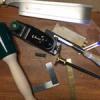Hi guys ! I just finished my first ever woodworking bench and it was also the 1st time I bought and used a plane, the veritas low angle jack. I had some very hard time planing the aprons and the top, I read scharwz's book on handplanes, watched many youtubes videos etc but I had a lot of tear out. I used some cheap and knotty 2x12 spruce lumber, which is all I have around here. I noticed most of the tear out occured around knots. So is there a way to deal with those knots beside skewing the plane, having a super sharp blade and taking really cuts ?
On a side note, can this low angle jack be used a smoother or do I really need a smoother for that ? What's the difference ? Thanks !




 Reply With Quote
Reply With Quote




 )
)
